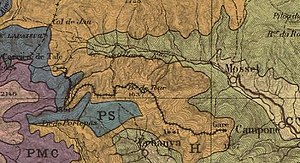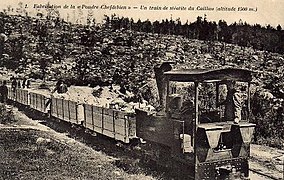Field railway of the domain of Cobazet
| Field railway of the domain of Cobazet Chemin de fer de la domaine de Cobazet |
|||||||||||||||||||||||||||||
|---|---|---|---|---|---|---|---|---|---|---|---|---|---|---|---|---|---|---|---|---|---|---|---|---|---|---|---|---|---|
|
Decauville locomotive Stéatite
| |||||||||||||||||||||||||||||
|
Route
| |||||||||||||||||||||||||||||
| Route length: | 1886–1950: 12 km around 1890 – around 1907: 7 km |
||||||||||||||||||||||||||||
| Gauge : | 600 mm ( narrow gauge ) | ||||||||||||||||||||||||||||
|
|||||||||||||||||||||||||||||
The field railway of the domain of Cobazet ( French Chemin de fer de la domaine de Cobazet ) was a 12 km long field railway operated from 1886 to 1950 in the Pyrenees near Mosset in France .
history
Baron Fernand Marie de Chefdebien-Zagarrira (1836–1914) bought the domain of Cobazet, a very large estate with 1851 hectares near Mosset, at an auction in 1883. In addition to willow and pine, fir and beech forests, this also included a quarry above the Refuge de Caillau refuge . The foreman Remy Jacomy (1818–1889) mined talc there .
The baron built a narrow-gauge railway to bring the soapstone ( French : Stéatite ) from the quarry at an altitude of 1,600 m to the Gare d'Estardé , the mountain station of a funicular at 1,220 m. In order to market the soapstone extracted in the quarry, he converted it in a chemical plant in Prades in Poudre Chefdebien , which was used against diseases of grapevines .
Track construction
The rails were each 6 meters long. They came from the Tamaris forge in Alès and were either straight or curved. The surveying engineer calculated the curves of the route so that their length was a multiple of 6 m. The first rails were delivered in numbered packages at the end of September 1885 so that assembly was as easy as possible, just like a Meccano kit.
On October 10, 1885, the first 330 meters of track were laid. After a winter break caused by the first snowfall, the section from Caillauet to Canrec began on May 14, 1886. Only a bridge over the Còrrec de Canrec was required on the route. The route was supposed to reach Cobazet no later than June 15, 1886 at a rhythm of 300 meters per day, which was adhered to despite delays caused by heavy rains. On June 19, 1886, the route reached the Col des Vigues. However, due to the poor substructure, there were many derailments, so that the route had to be improved.
Shorten the route
After the commissioning of an aerial cableway with which the swap bodies of the tipping lorries could be transported, the light railway route was shortened to 7 kilometers. The Gare d'Estardé was then decommissioned in 1916 and sold to the French army. The rest of the network was eventually shut down around 1950 when trucks could be used for transportation.
Rail vehicles
The Decauville locomotive Stéatite , procured by the baron as a third party , found it difficult to pull the empty wagons uphill in the arid area. Retrofitted funnel-shaped sand containers at the rear of the driver's cab indicate that the locomotive's wheels often spun.
| No. | Construction year | design type | Gauge | Empty weight |
Service weight |
Surname | Remarks |
|---|---|---|---|---|---|---|---|
| N ° 412 | 1904 | B n2t | 600 mm | 3.25 t | Stéatite | Decauville steam locomotive. Originally owned by Duncan Pingorial, later two other owners, then De Chefdebien & Cie, Mosset | |
| N ° 878, 880, 885, 889 and 918 | 600 mm | Five tilting lorries | |||||
| 600 mm | Two freight cars that were also used to transport people | ||||||
| Around 1913 | 600 mm | Bogie wagons for transporting logs or for transporting wooden swap bodies for stone or people |
Modelling
The locomotive is the prototype of the model train locomotive V10 manufactured by Jouef from 1967.
Individual evidence
- ↑ a b c d e f Chemin de ferde la carrière de talc, plan incliné et transporteur aérien du domaine de Cobazet.
Coordinates: 42 ° 40 ′ 2.4 " N , 2 ° 14 ′ 39.7" E



